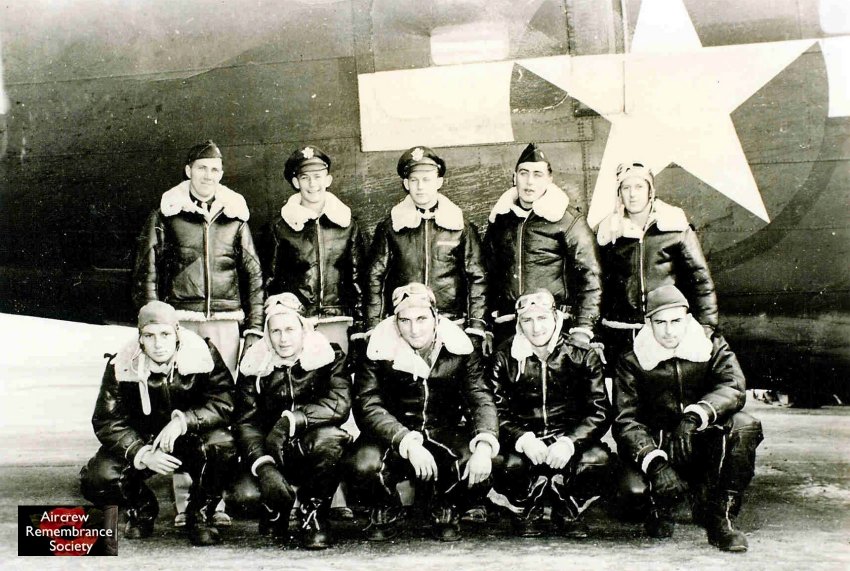Mission: Berlin, Germany
Date: 6th March 1944 (First daylight raid by U.S.A.A.F. on Berlin)
Unit: 754 Squadron (458 Bomb Group)
Type: Consolidated B-24 H-15 (Known as "450")
Serial No: 42-52450
Code: Z5
Location: Purmerend, Holland
Base: Horsham St. Faiths, Norfolk, England
Pilot: 2/Lt. Beverly E. Ballard, Jr. P.O.W.
Co pilot: 2/Lt. Harry S. Bengry Killed
Navigator: F/O Eugene J. Singer P.O.W.
Bombardier: 2/Lt. Roland W. Johnson P.O.W.
Radio/Op: S/Sgt James Nemeth Killed
Top turrett/Gnr: S/Sgt Edwin E. Sowles Killed
Ball turret/Gnr: Sgt Victor W. Krueger Evaded capture
Right waist/Gnr: Sgt Ralph C. Kracker P.O.W.
Left waist/Gnr: Sgt Raymond D. Rice P.O.W.
Tail/Gnr: Sgt James N. Lewis P.O.W.
Reason for Loss:
As told by Tom Kracker (The Researcher and our publisher of the "Tom Kracker" archives)
Ralph C. Kracker was born January 18, 1923 in Massillon, Ohio. He joined the Army Air Corps and after completion of his training in the B-24, was assigned to the 458th Bomb Group, 754th Bomb Squadron, stationed at Horsham St. Faith, Norwich, England. His B-24H, affectionately referred to as "450", was shot down on the second Berlin Raid on 6 March, 1944, one of 69 bombers lost that day. This was their 4th mission, the first three being decoy missions.
"Gallant Crew 52" (as they referred to themselves)

Standing Rear, L to R: Lt R.W. Johnson, Lt H.S. Bengry, Lt B.E. Ballard, F/O E.J. Singer and Sgt. J.N. Lewis
Kneeling Front, L to R: Sgt. R.D. Rice, Sgt. V.W. Krueger, Sgt. R.C. Kracker, S/Sgt. J. Nemeth and S/Sgt. E.E. Sowles (Courtesy Tom Kracker)
His B-24 had sustained serious flak damage over Berlin. Subsequently, they were attacked by three fighters, and they lost no:3 engine, which was the main drive for the hydraulic system. On the return, over Holland, the crew determined that the flak damage and three-engine strain was causing fuel loss at an alarming rate, and the pilot ordered them to bale out. Seven of the ten-man crew baled safely, three perished in the crash, unable to bale due to centrifugal force from the spinning. The AC crashed in Purmerend, Holland where a monument has been erected by Mr Just Kroon and many generous Dutch contributors, commemorating the crashes of the B-24, a Halifax HR 786 and a Lancaster ED 554.

Photo of the Tail Assembly showing the AC Serial number and a Large Letter "K" on the fin. A German guard can be seen sifting through the wreckage. (Courtesy Tom Kracker)


What appears to be the mid section of the AC with a German standing guard and right large section of the wing (Courtesy Tom Kracker)
After being rounded up by their captors, they were taken to Amsterdam for interrogation and medical treatment for those injured, including Ralph, who suffered shrapnel in the right leg and high back. While hospitalised, the German pilot, who seemingly received credit for the victory, Oblt Georg Kiefner, visited the injured.
Ralph explained that he never understood how the Germans knew who got the credit, since they sustained so many losses that day. The crew agreed, that the flak was really the cause of their demise.
(Note: we have not been able to find a claim by Oblt. Kiefner for this loss and we side on the belief that flak brought this B-24 down.)

This appears to be the nose, showing the two 50 cal MG's protruding from the wreckage. (Courtesy Tom Kracker)
These photos were taken by the Dutch Underground and given to Vic Krueger, who distributed to the surviving crew after the war.
He was held at Stalag Luft IV in Grosstychow, Stettin, Neuberg and was liberated at Moosberg, Stalag VIIA, by the 99th Infantry Division, including three of his grade school buddies! As the Russians began their push toward Germany, the prisoners were moved from Stalag Luft IV in the crowded hole of an Iron Ore boat for a three day trip on the Black Sea to Stettin. From Stettin, they were moved to the Neuberg Camp, where he mentions "the lovely stroll from the railroad", after two days in a boxcar. The last move was a "long march" to Moosberg, where he was eventually liberated.

The monument dedication, 2001
Sowles was the first to be found in the wreckage, seated in the co-pilot seat. Because no dog tags were found on the body, he was buried as "Unknown". Some days later, the bodies of Nemeth and Bengry were found near the bomb-bay, and they were buried next to Sowles. After the war, Sowles and Bengry were returned to the USA and Nemeth was buried in the American War Cemetery at Margraten, Limburg. Ralph Kracker passed away 27 February, 2000 in Santa Rosa, California.
